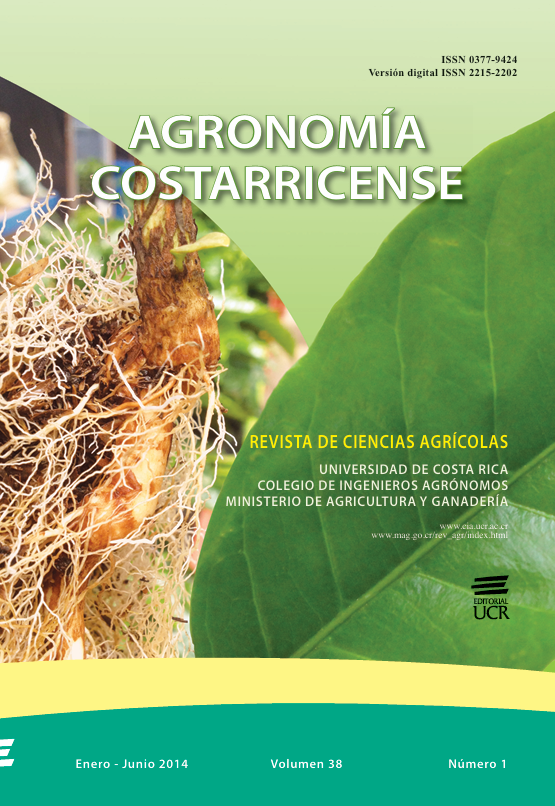Abstract
Bacillus thuringiensis is a Gram-positive bacteria forming spores, which produces parasporal crystals of a proteic nature, toxic against various orders of insects and biodegradable and harmless to other species. This research use the experimental model, allowing, through observation techniques, microbiological and biochemical identification of B. thuringiensis from soil samples from municipalities of Cúcuta, El Zulia, Los Patios, San Cayetano and Villa del Rosario, Norte de Santander, Colombia, and its subsequent characterization with molecular markers Bc-Rep and MB1. Microbiological and biochemical tests identified 10 isolates as B. thuringiensis; the results of phylogenetic analysis showed significant differences in the clusters obtained with Bc-Rep and MB1 markers. With Bc-Rep a low index of similarity (18%) was recorded, while with the marker MB1 a higher similarity index, 58%, was obtained. This work indicated a great genetic variability among isolates, showing that markers Bc-Rep and MB1 are highly effective to differentiate closely related strains, thus becoming a genetic tool of great value for studies of identification and diversity in B. thuringiensis.References
BARTOSZEWICZ M., KROTEN M., SWIECICKA I. 2013. Germination and proliferation of emetic Bacillus cereus sensu lato strains in milk. Folia Microbiológica. Springer Netherlands 58(6):529-535.
BERNAL E. 2011. Comparación socioeconómica de las empresas agrarias de producción ecológica y convencional en Aragón, España: Problemas y oportunidades. Mundo Agr. 11(2):1-28.
BRUMLIK M.J., BIELAWSKA A., ZAKOWSKA D., LIANG X., SPALLETTA R.A., PATRA G., DELVECCHIO V.G. 2004. Genetic diversity among Bacillus anthracis, Bacillus cereus and Bacillus thuringiensis strains using repetitive element polymorphism-PCR. Polish Journal of Microbiology 53(4):215-225.
BRUMLIK M.J., SZYMAJDA U., ZAKOWSKA D., LIANG X., REDKAR R.J., PATRA G., DEL VECCHIO V.G. 2001. Use of long-range repetitive element polymorphism-PCR to differentiate Bacillus anthracis strains. Appl. Environ. Microbiol. 67:3021-3028.
DWORKIN M., FALKOW S., ROSENBERG E., SCHLEIFER K.H., STACKEBRANDT E. 2006. The Prokaryotes. A handbook on the biology of bacteria (Third Edition), Springer. Chapt. 16. 4:530-563.
GALVIS F. 2013. Caracterización molecular de genes cry1, cry2, cry3 y cry4 en aislados de Bacillus thuringiensis y determinación de su actividad bioinsecticida en larvas de Aedes aegypti. Interciencia 38(02):128-131.
KATARA J., DESHMUKH R., SINGH N., KAUR S. 2012. Molecular typing of native Bacillus thuringiensis isolates from diverse habitats in India using REP-PCR and ERIC-PCR analysis. J. Gen. Appl. Microbiol. 58:83-94.
LÓPEZ S., CERÓN J. 2010. Proteínas Cry de Bacillus thuringiensis y su interacción con coleópteros. NOVA 8(14):183-194.
RAMÍREZ L., RAMÍREZ N., FUENTES L.S., JIMÉNEZ J., HERNÁNDEZ J. 2010. Estandarización de un bioensayo y evaluación preliminar de tres formulaciones comerciales de Bacillus thuringiensis sobre Tuta absoluta (Meyrick) (Lepidoptera: Gelechiidae). Rev. Colomb. Biotecnol. 12(1):12-21.
REALPE M., HERNÁNDEZ C., AGUDELO C. 2002. Especies del género Bacillus. Morfología macroscópica y microscópica. Biomédica 22:106-109.
REYES A., IBARRA J.E. 2005. Fingerprinting of Bacillus thuringiensis type strains and isolates by using Bacillus cereus Group-Specific Repetitive Extragenic Palindromic Sequence-Based PCR analysis. Appl. Environ. Microbiol. 71:1346-1355.
##plugins.facebook.comentarios##

This work is licensed under a Creative Commons Attribution-NonCommercial-NoDerivatives 4.0 International License.
Copyright (c) 2016 Agronomía Costarricense


